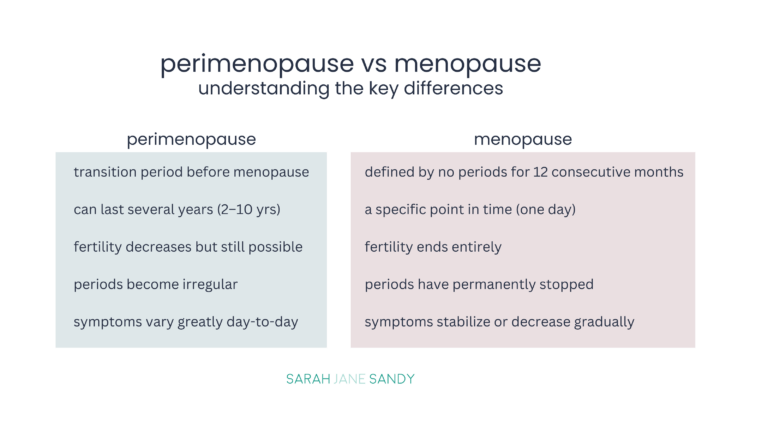

If you’ve found yourself lately thinking, “What is happening with my periods, am I going through menopause?! But isn’t it too early for that?” — you’re in good company.
The truth is, menopause doesn’t happen overnight. Instead, there’s a whole transition period called perimenopause. Think of it as your body’s gentle (and sometimes not-so-gentle!) journey into menopause, often beginning in your late 30s and/or 40s.
During this stage, your hormones — particularly estrogen and progesterone — begin to shift, creating changes in your menstrual cycles, emotions, sleep, libido, and even your body’s rhythms. It’s totally normal, incredibly common, and most importantly, completely manageable.
Whether you’re feeling subtle shifts — like occasional brain fog, moodiness, lower libido or cycle irregularities — or bigger signals like hot flashes, insomnia, or crippling anxiety — understanding symptoms of perimenopause and how to manage them can help you reclaim your confidence and find ways to feel like yourself again.
You’re not alone in this. In fact, millions of women are navigating this natural transition right alongside you. Let’s normalize it, embrace it, and empower ourselves to thrive through this next beautiful (even if sometimes challenging!) chapter.
A quick note: There’s no one-size-fits-all solution for perimenopause and hormone health — it’s about making the best-informed choices for you, based on your unique biochemistry, your symptoms, and your reality, so you feel confident and comfortable with your health decisions, and knowing you always have support along your journey. Remember that I’m here to educate and guide you, and I offer one-on-one consultations to dive into your unique story and journey and provide treatment recommendations catered to your needs.
First things first — let’s clear up the confusion between these two terms. While they’re closely related, perimenopause and menopause aren’t the same thing.
Perimenopause literally means “around menopause.” It’s the transition phase between premenopause (your fertile years) and menopause (after your fertile years). It typically starts in your late 30s or early-to-mid 40s and the transition can last anywhere from a few years to over a decade.
During this phase:
Think of perimenopause as your body’s way of gradually preparing you for the end of your reproductive years.
Menopause is officially defined as the point when you’ve had no menstrual period for 12 consecutive months. At this stage:
Menopause itself technically refers to a single day — the day marking 12 consecutive months since your last menstrual period. After this point, you’re considered postmenopausal.

Ever wonder if the sudden changes you’re noticing — like mood swings, irregular periods, weight gain, or that unexpected “brain fog” — mean you might be entering perimenopause? You’re definitely not alone. This phase can feel confusing, especially because it doesn’t announce itself with clear-cut signals.
These are the classic signs and symptoms most women start to notice as they enter perimenopause:
Irregular periods
what it looks like: Cycles become unpredictable. Periods might arrive sooner or later than expected, be shorter, longer, heavier, lighter—or even skip months entirely.
why it happens: Hormonal fluctuations (particularly estrogen and progesterone) disrupt your cycle’s regular rhythm.
Mood swings and emotional shifts
what it feels like: Increased irritability, frustration, sudden tears, or feelings of sadness that seem out of character.
why it happens: Sudden estrogen fluctuations combined with dropping progesterone levels directly impact your mood-stabilizing neurotransmitters.
Sleep disturbances and insomnia
what it feels like: Difficulty falling asleep, waking frequently at night, waking up feeling unrested.
why it happens: Low progesterone levels, night sweats, anxiety, and changing estrogen levels interfere with deep, restful sleep.
Hot flashes and night sweats
what it feels like: Sudden heat surges causing flushing, sweating, chills, rapid heartbeat, or feeling overheated, especially at night.
why it happens: Rapid drops in estrogen confuse your body’s internal thermostat.

Perimenopause often brings subtle changes that sneak up quietly. If you’re experiencing some of these lesser-known signs and symptoms of perimenopause, you might also be entering this transitional stage:
Changes in libido (sex drive)
what it feels like: Decreased desire, diminished arousal, or reduced satisfaction during intimacy.
why it happens: Hormonal changes, especially lower testosterone and fluctuating estrogen, impact sexual desire, sensation, and vaginal lubrication.
Brain fog and memory issues
what it feels like: Difficulty concentrating, forgetfulness, confusion, or feeling mentally “fuzzy.”
why it happens: Shifting estrogen affects neurotransmitters, impacting cognitive clarity, memory, and processing speed.
Increased anxiety or nervousness
what it feels like: Unexplained anxiety, worry, racing thoughts, or heightened stress responses.
why it happens: Lower progesterone (your calming hormone) combined with unstable estrogen triggers anxiety or heightened emotional sensitivity.
Weight gain, especially around the middle
what it looks like: Unexplained weight gain around your abdomen or difficulty losing weight despite unchanged habits.
why it happens: Hormonal shifts cause metabolism to slow, promoting fat storage around your belly. Estrogen fluctuations also influence appetite regulation.
Increased PMS-like symptoms
what it feels like: More intense or prolonged PMS symptoms like bloating, breast tenderness, irritability, and mood swings—even when your period doesn’t arrive.
why it happens: Imbalanced estrogen-to-progesterone ratio makes PMS symptoms more pronounced, even outside your typical menstrual rhythm.
Skin and hair changes
what it looks like: Drier skin, loss of elasticity, more wrinkles, skin pigmentation, acne flare-ups, or hair thinning.
why it happens: Lower estrogen reduces collagen production and oil balance, affecting hair and skin health.
Digestive changes
what it feels like: Increased bloating, gas, constipation, or digestive discomfort.
why it happens: Hormonal fluctuations (particularly estrogen shifts) influence gut health, digestion, and even microbiome balance.
It’s easy to feel like your body is acting unpredictably, but there’s actually logic behind these symptoms — they’re your body’s natural response to shifting hormone levels. Recognizing these signs, even the subtle ones, helps you proactively manage your health, seek appropriate support, and feel less overwhelmed by unexpected changes.
During perimenopause, it can be common to feel like your emotions, cycles, and even your body’s rhythms are out of sync, leaving you wondering, “What on earth is going on with my body?” The answer lies in your hormones — specifically estrogen, progesterone, and testosterone.
During perimenopause, estrogen becomes your body’s wild child — unpredictable and constantly fluctuating. Estrogen regulates your menstrual cycle, keeps bones strong, maintains vaginal health, supports mood stability, and even influences skin elasticity and metabolism.
what happens during perimenopause
Instead of steadily rising and falling in a predictable cycle each month, estrogen begins to surge unpredictably, rising high one day, then dropping rapidly the next. Imagine it as a rollercoaster that’s exhilarating some days and uncomfortable on others.
Think of progesterone as estrogen’s calming counterpart. It typically rises after ovulation to balance estrogen’s stimulating effects, promote restful sleep, and stabilize mood.
what happens during perimenopause
As ovulation becomes irregular, progesterone levels decline. Progesterone is made from the empty egg sac that remains after ovulation so with fewer ovulations, your body produces less progesterone, leaving estrogen’s fluctuations unchecked.
Women naturally produce testosterone (though much less than men), and it’s crucial for overall well being — it influences libido, mood, energy, muscle mass, metabolism, and even cognitive clarity.
what happens during perimenopause
Testosterone levels usually begin to gradually decline — typically more slowly and subtly than estrogen and progesterone.
Your hormones function as a delicate ecosystem, each affecting and balancing the others. During perimenopause, declining testosterone interacts with fluctuating estrogen and progesterone:
When estrogen becomes erratic, your body’s sensitivity to testosterone changes. This interplay can intensify libido fluctuations, mood swings, or cognitive challenges.
and
Low progesterone can exacerbate emotional shifts and anxiety, making the symptoms from reduced testosterone feel even more pronounced.
These hormonal ups and downs don’t just stay quietly behind the scenes — they impact your fertility and well-being in noticeable ways:
Irregular ovulation: Estrogen fluctuations mean ovulation isn’t triggered on a consistent basis. Progesterone’s decline further complicates things, affecting the regularity and predictability of ovulation.
Shorter fertile windows: Even if ovulation occurs, cycles become less predictable, shortening your fertile window and making conception trickier.
Lower egg quality: Hormonal shifts and increased age coincide with decreasing egg quality, making pregnancy more difficult (though still possible).
Mood and emotional health: Lower progesterone (your calming hormone) and fluctuating estrogen often trigger irritability, anxiety, mood swings, or sadness. These emotional shifts are common, valid, and hormone-driven.
Sleep disruptions: Lower progesterone disrupts sleep quality, contributing to insomnia, restless nights, or waking frequently.
Metabolism changes and weight gain: Hormonal imbalances can slow metabolism or increase belly fat storage.
Hot flashes and night sweats: Rapid drops in estrogen trigger your body’s thermostat, causing sudden overheating or chills.
Energy and brain fog: Unpredictable hormones can make you feel fatigued, forgetful, or struggle with concentration.
Feeling baffled by your symptoms? Here’s how they directly connect to hormonal fluctuations:
Irregular or heavy periods → Estrogen dominance and progesterone deficiency
Without balanced progesterone, estrogen goes unchecked, causing irregular cycles, anovulatory cycles, heavy flow, or prolonged bleeding.
Mood swings and anxiety → Low progesterone and estrogen instability
When progesterone dips, calming effects decrease, leaving you more vulnerable to mood swings and increased anxiety.
Hot flashes and night sweats → Sudden drops in estrogen
Abrupt declines in estrogen cause temperature regulation issues, leading to uncomfortable hot flashes.
Vaginal dryness and painful sex → Decreasing estrogen levels
Estrogen maintains vaginal moisture and elasticity; its decline leads to dryness, discomfort, or intimacy challenges.
Brain fog and fatigue → Hormonal turbulence (especially estrogen fluctuations)
Frequent hormonal swings impact your neurotransmitters, causing forgetfulness, fatigue, and concentration issues.

When you hear the word “perimenopause,” fertility probably isn’t the first thing that comes to mind. But, if you’re in your late 30s to late 40s and wondering about fertility and changes in your menstrual cycles, understanding what’s going on is super important. It’s also important to understand that fertility doesn’t vanish overnight — it gently decreases over time. Here’s why:
Declining egg quantity: Women are born with a fixed number of eggs. By your late 30s and 40s, your egg reserve naturally diminishes. Fewer eggs means fewer opportunities for conception, making pregnancy still possible, but less predictable.
Reduced egg quality: As we age, the quality of eggs declines, which can lead to increased chances of chromosomal abnormalities, miscarriages, or difficulty conceiving.
Hormonal changes and imbalance: Fluctuating estrogen, progesterone, and follicle-stimulating hormone (FSH) levels can disrupt regular ovulation, making conception trickier.
Even though fertility has declined, pregnancy remains possible — especially in the earlier stages of perimenopause. In fact, perimenopausal women who aren’t trying to conceive are often surprised by unexpected pregnancies, precisely because ovulation is unpredictable.
If you’re hoping to conceive, be proactive about fertility checks and interventions. Consider:
If pregnancy isn’t desired, continue contraception until menopause (12 months without periods) is confirmed.
Navigating perimenopause can sometimes feel like you don’t know which way is up. The good news? There are plenty of practical, doable steps you can take right now to support your body, mind, and hormonal health through the transition.
What you put on your plate can make a big difference in how your hormones behave, how you feel day-to-day, and how well your body handles perimenopause symptoms.
Here’s what to prioritize:
Healthy fats are essential for hormone production and regulation.
Foods to eat: Avocado, olive oil, nuts and seeds, fatty fish (salmon, sardines), egg yolks, coconut oil.
Benefit: Supports hormone production, estrogen balance, reduces inflammation, and boosts mood and cognitive function.
Fiber helps flush excess hormones from your body and keeps digestion smooth, reducing bloating.
Foods to eat: Leafy greens, berries, beans, lentils, avocados, cruciferous vegetables, whole non-gluten grains (like oats and quinoa).
Benefit: Balances estrogen levels, reduces bloating, and supports weight management.
These veggies naturally help your liver process and eliminate excess estrogen.
Foods to eat: Broccoli, cauliflower, kale, Brussels sprouts, cabbage.
Benefit: Reduces symptoms of estrogen dominance (like heavy bleeding, breast tenderness, mood swings).
Eating enough high quality protein helps stabilize blood sugar, mood, and metabolism. Aim for 1 gram of high quality protein per pound of ideal body weight per day.
Foods to eat: organic grass-fed red meat, organic pasture-raised chicken, turkey and pork, wild caught fish & seafood, organic pasture-raised eggs, legumes, organic tofu.
Benefit: Reduces cravings, stabilizes energy levels, and supports ideal body weight, muscle mass and bone health.
Omega-3s are powerful anti-inflammatory agents that also benefit brain health.
Foods to eat: Wild caught fatty fish (salmon, sardines, herring, mackerel), chia seeds, flaxseeds, walnuts, organic pasture-raised egg yolks.
Benefit: Decreases inflammation, reduces hot flashes, supports mood and brain function.
Small, consistent lifestyle changes can dramatically ease symptoms:
Aim for at least 45-60 minutes of daily movement (walking, jogging, hiking, biking, swimming, yoga, pilates), combined with resistance training (with heavy weights) at least 2-3 times per week. Regular exercise reduces hot flashes, improves sleep quality, supports weight management, and boosts mood.
Create calming bedtime routines, minimize screen-time before bed, sleep in a pitch black room, and keep a consistent sleep schedule. Get at least 7-9 hours of sleep per night. High quality, restorative sleep reduces stress hormones, improves mood, and helps regulate hormones involved in menstrual cycles and metabolism.
Stress strongly influences hormone balance — especially during perimenopause. Get outside as often as possible, spend time in nature, try mindfulness practices, meditation, yoga, gentle walks, or journaling. Take intentional breaks throughout your day. Intentionally reducing your day to day stressors helps to reduce cortisol levels, calm anxiety, and supports healthy progesterone production.
Perimenopause lab tests are typically not necessary to diagnose perimenopause, as it is a transition period with no specific diagnostic criteria. However, certain tests may be helpful to assess symptoms and rule out other underlying conditions.
Progesterone: measures the level of another female hormone that fluctuates during perimenopause.
Estradiol: measures the level of the primary female hormone, which declines during perimenopause.
Testosterone: measures the level of another female hormone that fluctuates during perimenopause.
Follicle-stimulating hormone (FSH): a hormone that increases as menopause approaches. High FSH levels can indicate perimenopause.
Luteinizing hormone (LH): another hormone that increases as menopause approaches.
TSH, free T3, free T4: to rule out thyroid disorders, which can cause similar symptoms to perimenopause.
Hemoglobin A1c, fasting insulin, fasting glucose: blood sugar tests to check for pre-diabetes and/or diabetes, which can also cause some perimenopause symptoms.
Bone density test: to assess the risk of osteoporosis, which is more common in postmenopausal women.
It’s important to note that hormone levels can fluctuate significantly during perimenopause. Therefore, a single hormone test may not be a reliable indicator of perimenopause. Your doctor may recommend multiple tests or repeat tests over time to monitor your hormone levels.
Targeted supplements can gently help your body cope with hormonal fluctuations. Here are my favorite, research-backed supplements for perimenopause:
Magnesium: improves sleep, calms anxiety, reduces PMS symptoms, eases muscle cramps.
Omega-3 Fatty Acids: decreases inflammation, reduces mood swings and depression, supports brain health, reduces hot flashes.
Adrenotone: balances stress hormones, supports a healthy menstrual cycle, and optimizes energy.
FemGaurd: promotes hormonal balance, healthy estrogen metabolism, antioxidant status, and efficient detoxification of excess hormones.
Zinc: critical for the production of testosterone production, having enough testosterone eases the perimenopausal transition.
Vitamin D: supports mood, immune function, and bone health; may reduce symptoms like depression and fatigue.
Important Note: Always consult with your healthcare provider before starting any supplement to ensure safety, especially if you’re already taking medications.

Perimenopause doesn’t just impact your body — it can deeply influence your emotional world too. If you’ve found yourself suddenly teary, anxious, overwhelmed, or simply “not yourself,” please know these feelings are incredibly common. Your emotional wellbeing matters just as much as your physical health, especially during this season of hormonal shifts.
Before we jump into solutions, it’s crucial to acknowledge why emotional wellness takes center stage during perimenopause:
Hormonal shifts (especially estrogen and progesterone fluctuations) directly influence neurotransmitters like serotonin and dopamine, impacting mood stability.
Dropping progesterone (your natural “calming hormone”) can heighten anxiety and make stress harder to manage.
Sleep disturbances from hot flashes or night sweats exacerbate mood swings, irritability, and anxiety.
Simply put, emotional fluctuations during perimenopause are normal, biological responses.
Here are gentle, practical, and effective ways to support yourself emotionally during this transitional time:
Whether it’s yoga, walking in nature, dancing, or running, prioritize moving your body in ways that you enjoy every single day. Physical movement helps release mood-boosting endorphins, reduces anxiety, and improves sleep quality.
Calming bedtime rituals — like a warm bath, herbal tea, or reading — signal your body it’s safe to unwind. Better sleep significantly reduces emotional sensitivity, stabilizes mood, and helps your body regulate hormones naturally.
Choose foods rich in healthy fats (avocado, nuts, fish), high quality protein (meat, fish, eggs, legumes), and complex carbs (whole non-gluten grains, starchy root vegetables) to help stabilize your mood. Proper nutrients balance brain chemistry, lower inflammation, support blood sugar balance, and improve mood regulation. Limit caffeine and alcohol — both can exacerbate anxiety, mood swings, and sleep disruptions.
Even a few minutes daily of mindfulness meditation or gentle breathing exercises can significantly reduce anxiety and mood swings. Apps like Calm, Headspace, or Insight Timer can offer guided sessions that ease stress.
Try short emotional “check-ins” throughout your day — ask yourself how you’re feeling and allow space to process emotions without judgment. Recognizing and validating your emotions builds emotional resilience and reduces overwhelm.
Remember to listen to your body!
Your body is intuitive — it’ll tell you what’s helping and what’s not. Experiment gently, listen carefully, and trust what works for you. Perimenopause might be a journey of adjustments, but it can also be a powerful period of personal empowerment and self-care.
Hormone Replacement Therapy (HRT) can be used as a complementary treatment alongside diet, supplements, and lifestyle adjustments.
HRT involves taking medications (either synthetic or bioidentical) to replenish hormones that your body stops producing naturally during perimenopause and menopause. It’s designed to ease symptoms by balancing estrogen, progesterone, and testosterone.
I am a strong proponent of using bioidentical hormone replacement therapy, not synthetic hormones. I am also an advocate of working with a trained practitioner to find the right dose for you, and to engage in consistent regular testing and monitoring of levels so appropriate adjustments can be made as needed. Too much hormone can be just as bad as too little hormone.
Many women experience relief from uncomfortable symptoms like:
Hot flashes and night sweats: Often dramatically reduced, improving sleep and overall comfort.
Mood stability and emotional health: Helps balance mood swings, anxiety, and mild depression caused by hormone fluctuations.
Bone health: Estrogen supports bone density, lowering the risk of osteoporosis.
Vaginal and sexual health: Reduces dryness, painful intercourse, and improves libido and intimacy.
Skin and hair: May help maintain skin elasticity and thickness, potentially slowing skin aging.
In short, HRT can be a game-changer in restoring quality of life and comfort during perimenopause.
Like most medical treatments, HRT isn’t risk-free, and it’s essential to have balanced information to make informed choices. Potential risks can include:
Blood clots and stroke: Small increased risk, especially with oral estrogen and for women who smoke or have cardiovascular risk factors.
Heart disease: Risks vary depending on timing — starting HRT close to menopause usually presents fewer risks than starting later.
Uterine cancer: Risk increases when estrogen alone is given without progesterone. Using combined estrogen-progesterone therapy helps minimize this risk.
The good news? Many of these risks can be minimized by carefully selecting the type, timing, dosage, and delivery method (like creams, patches, gels, or pills) of your therapy, tailored specifically to your health and needs.
Let’s clear the air and address some common misconceptions you might have heard about HRT:
Myth #1: “HRT is unsafe for everyone.”
Truth: While not risk-free, it’s safe and effective for many women, especially when using bioidentical hormones that are started early (around perimenopause onset). Individualized treatment with regular monitoring minimizes most risks.
Myth #2: “HRT always causes weight gain.”
Truth: There’s no direct evidence HRT itself causes weight gain. Usually, mid-life hormonal changes, lifestyle factors, and metabolism shifts are behind those extra pounds — not HRT specifically.
Myth #3: “Natural treatments are always safer.”
Truth: Natural doesn’t always mean safer or more effective. Bioidentical hormones (derived from plant sources but chemically identical to human hormones) can have similar risks as synthetic versions if not monitored properly. It’s always about proper dosage, monitoring, and individual suitability.
Myth #4: “You have to stop HRT after five years.”
Truth: There’s no strict rule about duration. Decisions about continuing therapy depend on your symptoms, health history, and lifestyle.
Myth #5: “HRT delays menopause forever.”
Truth: HRT doesn’t prevent or delay menopause. It simply reduces symptoms while you’re experiencing them. When you stop HRT, your body naturally resumes its hormonal path.

Navigating perimenopause can feel like a rollercoaster — some days you’re handling it like a champ, and other days you might feel overwhelmed and unsure about what’s “normal.” While many perimenopausal symptoms are typical, some signs deserve extra attention from your healthcare provider. Here’s a list of symptoms you definitely shouldn’t overlook:
Periods that last longer than 7 days, soaking through pads or tampons every hour or two, or passing large blood clots could indicate uterine fibroids, endometrial polyps, cysts, and risk of anemia.
Unpredictable spotting or bleeding happening between your regular cycles. Though common in perimenopause, persistent spotting can occasionally signal hormonal irregularities or other conditions needing evaluation.
Persistent sadness, feelings of hopelessness, panic attacks, anxiety interfering with daily life, or thoughts of harming yourself. Significant hormonal shifts can dramatically impact mental health.
Hot flashes that severely disrupt your sleep, work, or daily activities might require additional interventions like lifestyle changes or hormone therapy.
Rapid weight changes despite no significant changes in your diet or exercise habits might indicate hormonal issues, insulin resistance, or thyroid imbalance — each treatable with the right medical support.
Lower estrogen levels during perimenopause often cause vaginal dryness,discomfort, burning, or pain during intimacy, but treatment options are simple and effective, dramatically improving quality of life and intimacy.
Increased urgency, frequency, burning, or recurrent urinary tract infections (UTIs) could signal hormonal changes affecting your bladder or pelvic floor muscles, often manageable with lifestyle adjustments, pelvic floor therapy, or topical treatments.
Hormonal fluctuations can influence your heart, but it’s important to rule out any underlying heart condition or thyroid issues.
Lumps, swelling, skin dimpling, persistent pain, or nipple discharge could be harmless hormonal changes but warrant immediate evaluation to rule out anything more serious.
Trust your instincts!
Always listen to your body. If you sense something is off — even if you can’t quite pinpoint what it is — do not hesitate to talk to your healthcare provider and ask for appropriate testing and evaluation.
Navigating perimenopause can feel scary, isolating, and overwhelming — but you don’t have to do it alone!
From nutritional tweaks to gentle lifestyle adjustments, and even targeted supplements or hormone therapy, you have options when it comes to supporting your body (and mind!) through this natural transition.
Remember, perimenopause isn’t just a stage to “get through” — it’s a powerful opportunity to nurture yourself, reconnect with your body, and create deeper emotional resilience.
Above all, trust your intuition, embrace self-compassion, and celebrate your strength as you navigate this new chapter. Perimenopause may mark the end of one season, but it also opens the door to a deeper understanding and appreciation of yourself.
You’ve got this!
Mood Changes During Perimenopause Are Real. Here’s What to Know. | ACOG
Perimenopause symptoms, severity, and healthcare seeking in women in the US | npj Women’s Health
The Mental Health Aspects of Menopause | Harvard Medicine Magazine
Perimenopause: From Research to Practice – PMC
Perimenopause: Rocky road to menopause – Harvard Health
The Importance of Nutrition in Menopause and Perimenopause—A Review
Menopause transition: Physiology and symptoms – ScienceDirect
These are the classic signs and symptoms most women start to notice as they enter perimenopause:
Targeted supplements can gently help your body cope with hormonal fluctuations. Here are my favorite, research-backed supplements for perimenopause:
Magnesium: improves sleep, calms anxiety, reduces PMS symptoms, eases muscle cramps.
Omega-3 Fatty Acids: decreases inflammation, reduces mood swings and depression, supports brain health, reduces hot flashes.
Adrenotone: balances stress hormones, supports a healthy menstrual cycle, and optimizes energy.
FemGaurd: promotes hormonal balance, healthy estrogen metabolism, antioxidant status, and efficient detoxification of excess hormones.
Zinc: critical for the production of testosterone production, having enough testosterone eases the perimenopausal transition.
Vitamin D: supports mood, immune function, and bone health; may reduce symptoms like depression and fatigue.
Important Note: Always consult with your healthcare provider before starting any supplement to ensure safety, especially if you’re already taking medications.
Perimenopause literally means “around menopause.” It’s the transition phase between premenopause (your fertile years) and menopause (after your fertile years). It typically starts in your late 30s or early-to-mid 40s and the transition can last anywhere from a few years to over a decade.
Menopause itself technically refers to a single day — the day marking 12 consecutive months since your last menstrual period. After this point, you’re considered postmenopausal.
The Fertility Code is the best-kept secret of women who want to take the guesswork out of conceiving, and give themselves every possible chance of getting, and staying, pregnant successfully.
Bringing together a personalized & custom approach, evidence-based information, science-backed protocols, and nurturing practices, this course is for anyone who is struggling to get pregnant, or thinking about getting pregnant soon. The course is a one-stop-shop for getting your body, mind and soul prepared for conception.
In less than 3 months, you will learn exactly what you need to do now to get pregnant successfully and have a healthy full term pregnancy with The Fertility Code.
Sarah Jane Sandy is a certified nutrition therapist, and a fertility and women’s health expert. She has helped hundreds of women increase their fertility naturally and go on to have healthy full-term pregnancies. She has been working with women and couples trying to get pregnant for over 16 years and over 90% of the women who work with her get pregnant and have healthy babies.
She also works with women trying to fix their hormone imbalances, as well as supporting women through pregnancy and the postpartum period. Learn more about her own fertility and hormone journey here. To send Sarah a message, complete her Contact Form.

Curious about your fertility health? Take this simple quiz to find out what factors may be harming your fertility, and learn what you can do about it!